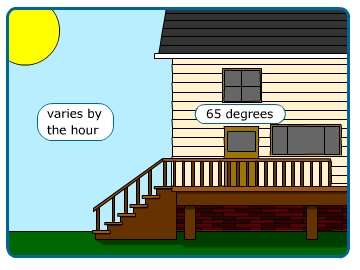7.2: Residential Heat Loss (II)
- Page ID
- 47192
Heating Degree Days
Local weather or climatic conditions are one of three factors that affects the amount of heat loss through conduction. When examining weather conditions, we look at both the inside and outside temperature of a home.
As shown in Figure 7.2.1, the inside temperature is usually taken as a standard comfort temperature of 65ºF. The outside temperature varies by the hour. Knowing this information can help us to understand two concepts:
- Average outside temperature = Average of the maximum and minimum temperature during the day
- Heating Degree Day (HDD) = The temperature difference through which air has to be treated, or how many degrees the mean temperature fell below 65ºF for the day. It is also an index of fuel consumption.

Figure 7.2.1 Temperatures inside and outside a house
Determining HDD
The formula for determining the HDD is
\[ HDD = T_{base} − T_a \]
where Ta is the average outside temperature given by
\[ T_a = \dfrac{T_{max} + T_{min}}{2} \]
To calculate HDD:
- Determine the base temperature (i.e., inside temperature), which is usually about 65°F.
- Find the day's average outside temperature using equation 7.2.2.
- Use equation 7.2.1 to find the HDD.
Note
If the Ta is equal to or above 65 ºF, there are no heating degree days for that 24-hour period, or HDD = 0.
Example Problem
Example 1
Calculate the HDD for one day when the average outside temperature is:
(a) 13°F
(b) 2°C
- Answer
-
Part (a)
Using equation 7.2.1,
\[ HDD = 65 - 13 = 52°F \nonumber\]
Part (b)
Convert the temperature to Fahrenheit to get 2°C = 35.6°F.
Then, using equation 7.2.1,
\[ HDD = 65 - 35.6 = 29.4°F \nonumber\]


